FIAT 500E 2016 2.G Owner's Guide
Manufacturer: FIAT, Model Year: 2016, Model line: 500E, Model: FIAT 500E 2016 2.GPages: 132, PDF Size: 4.59 MB
Page 31 of 132
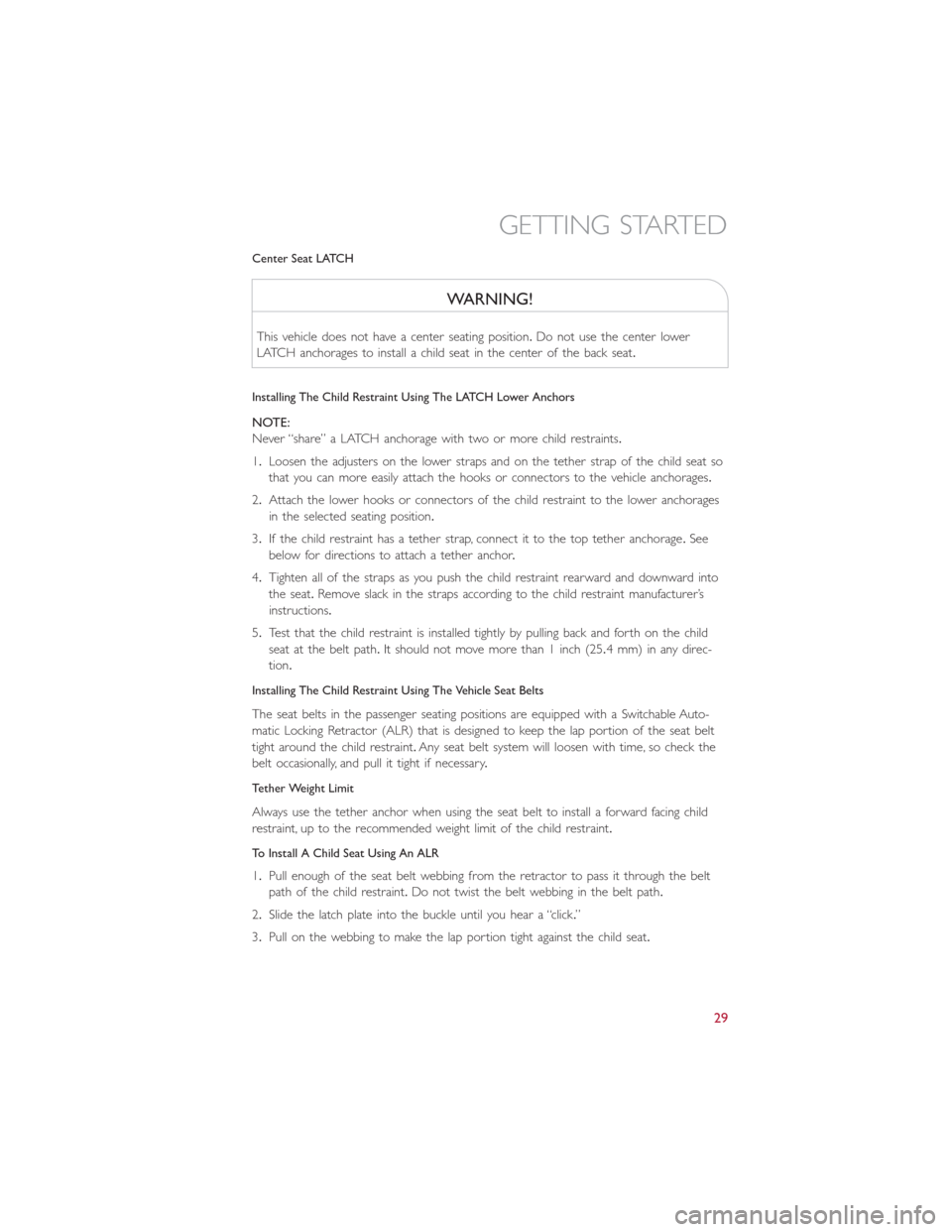
Center Seat LATCH
WARNING!
This vehicle does not have a center seating position.Do not use the center lower
LATCH anchorages to install a child seat in the center of the back seat.
Installing The Child Restraint Using The LATCH Lower Anchors
NOTE:
Never “share” a LATCH anchorage with two or more child restraints.
1.Loosen the adjusters on the lower straps and on the tether strap of the child seat so
that you can more easily attach the hooks or connectors to the vehicle anchorages.
2.Attach the lower hooks or connectors of the child restraint to the lower anchorages
in the selected seating position.
3.If the child restraint has a tether strap, connect it to the top tether anchorage.See
below for directions to attach a tether anchor.
4.Tighten all of the straps as you push the child restraint rearward and downward into
the seat.Remove slack in the straps according to the child restraint manufacturer’s
instructions.
5.Test that the child restraint is installed tightly by pulling back and forth on the child
seat at the belt path.It should not move more than 1 inch (25.4 mm) in any direc-
tion.
Installing The Child Restraint Using The Vehicle Seat Belts
The seat belts in the passenger seating positions are equipped with a Switchable Auto-
matic Locking Retractor (ALR) that is designed to keep the lap portion of the seat belt
tight around the child restraint.Any seat belt system will loosen with time, so check the
belt occasionally, and pull it tight if necessary.
Tether Weight Limit
Always use the tether anchor when using the seat belt to install a forward facing child
restraint, up to the recommended weight limit of the child restraint.
To Install A Child Seat Using An ALR
1.Pull enough of the seat belt webbing from the retractor to pass it through the belt
path of the child restraint.Do not twist the belt webbing in the belt path.
2.Slide the latch plate into the buckle until you hear a “click.”
3.Pull on the webbing to make the lap portion tight against the child seat.
GETTING STARTED
29
Page 32 of 132

4.To lock the seat belt, pull down on the shoulder part of the belt until you have pulled
all the seat belt webbing out of the retractor.Then, allow the webbing to retract back
into the retractor.As the webbing retracts, you will hear a clicking sound.This means
the seat belt is now in the Automatic Locking mode.
5.Try to pull the webbing out of the retractor.If it is locked, you should not be able to
pull out any webbing.If the retractor is not locked, repeat the last step.
6.Finally, pull up on any extra webbing to tighten the lap portion around the child re-
straint while you push the child restraint rearward and downward into the vehicle
seat.
7.If the child restraint has a top tether strap and the seating position has a top tether
anchorage, connect the tether strap to the anchorage and tighten the tether strap.
See below for directions to attach a tether anchor.
8.Test that the child restraint is installed tightly by pulling back and forth on the child
seat at the belt path.It should not move more than 1 inch (25.4 mm) in any direc-
tion.
Installing The Top Tether Strap (With Either Lower Anchors Or Vehicle Seat Belt):
When installing a forward-facing child restraint, always secure the top tether strap, up to
the tether anchor weight limit, whether the child restraint is installed with the lower an-
chors or the vehicle seat belt.
Tether Strap Installation
1.Route the tether strap to provide the most direct path for the strap between the
anchor and the child seat.
2.If your vehicle is equipped with adjustable rear head restraints, raise the head restraint,
and where possible, route the tether strap under the head restraint and between the
two posts.If not possible, lower the head restraint and pass the tether strap around
the outboard side of the head restraint.
Rear Seat Tether Strap Attachment
GETTING STARTED
30
Page 33 of 132
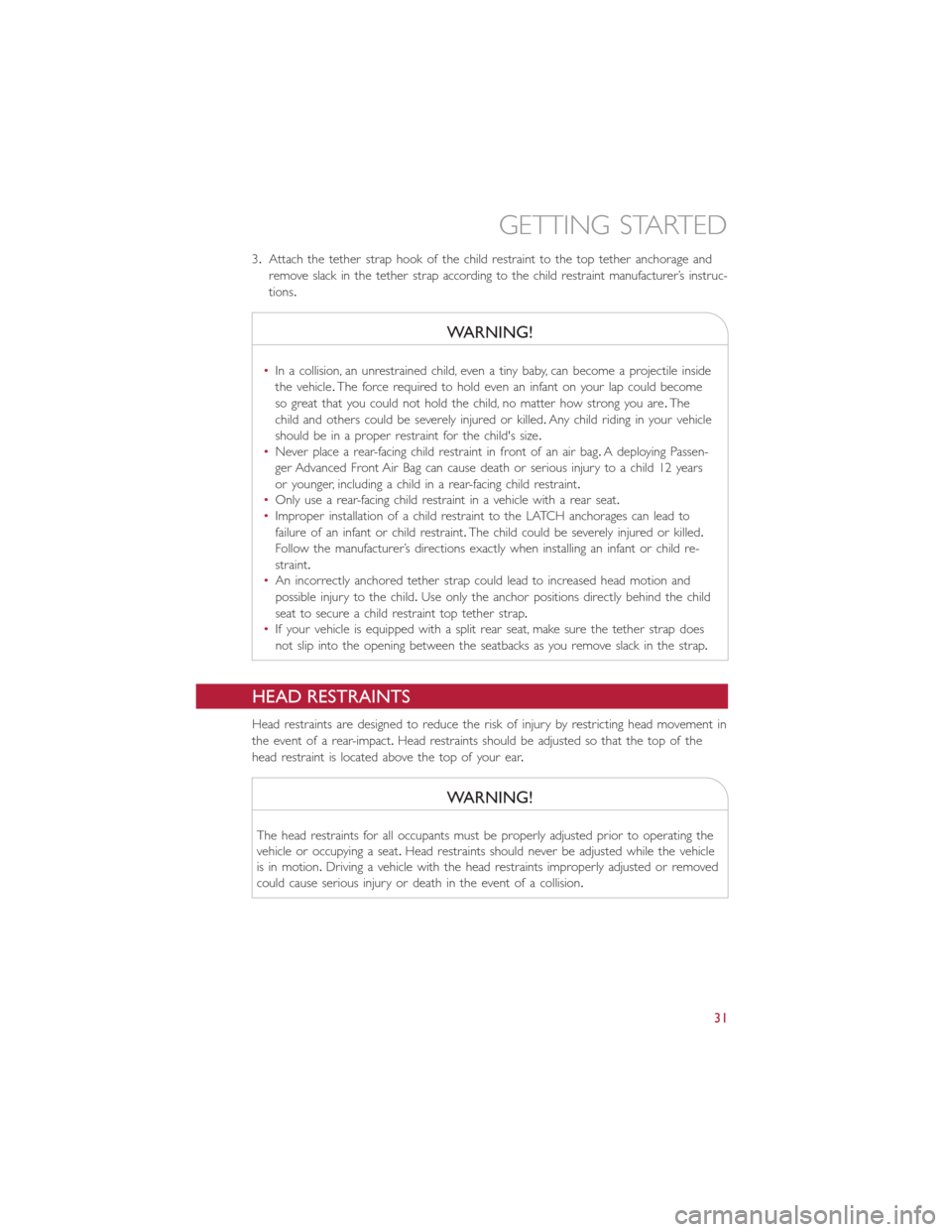
3.Attach the tether strap hook of the child restraint to the top tether anchorage and
remove slack in the tether strap according to the child restraint manufacturer’s instruc-
tions.
WARNING!
•In a collision, an unrestrained child, even a tiny baby, can become a projectile inside
the vehicle.The force required to hold even an infant on your lap could become
so great that you could not hold the child, no matter how strong you are.The
child and others could be severely injured or killed.Any child riding in your vehicle
should be in a proper restraint for the child's size.
•Never place a rear-facing child restraint in front of an air bag.A deploying Passen-
ger Advanced Front Air Bag can cause death or serious injury to a child 12 years
or younger, including a child in a rear-facing child restraint.
•Only use a rear-facing child restraint in a vehicle with a rear seat.
•Improper installation of a child restraint to the LATCH anchorages can lead to
failure of an infant or child restraint.The child could be severely injured or killed.
Follow the manufacturer’s directions exactly when installing an infant or child re-
straint.
•An incorrectly anchored tether strap could lead to increased head motion and
possible injury to the child.Use only the anchor positions directly behind the child
seat to secure a child restraint top tether strap.
•If your vehicle is equipped with a split rear seat, make sure the tether strap does
not slip into the opening between the seatbacks as you remove slack in the strap.
HEAD RESTRAINTS
Head restraints are designed to reduce the risk of injury by restricting head movement in
the event of a rear-impact.Head restraints should be adjusted so that the top of the
head restraint is located above the top of your ear.
WARNING!
The head restraints for all occupants must be properly adjusted prior to operating the
vehicle or occupying a seat.Head restraints should never be adjusted while the vehicle
is in motion.Driving a vehicle with the head restraints improperly adjusted or removed
could cause serious injury or death in the event of a collision.
GETTING STARTED
31
Page 34 of 132
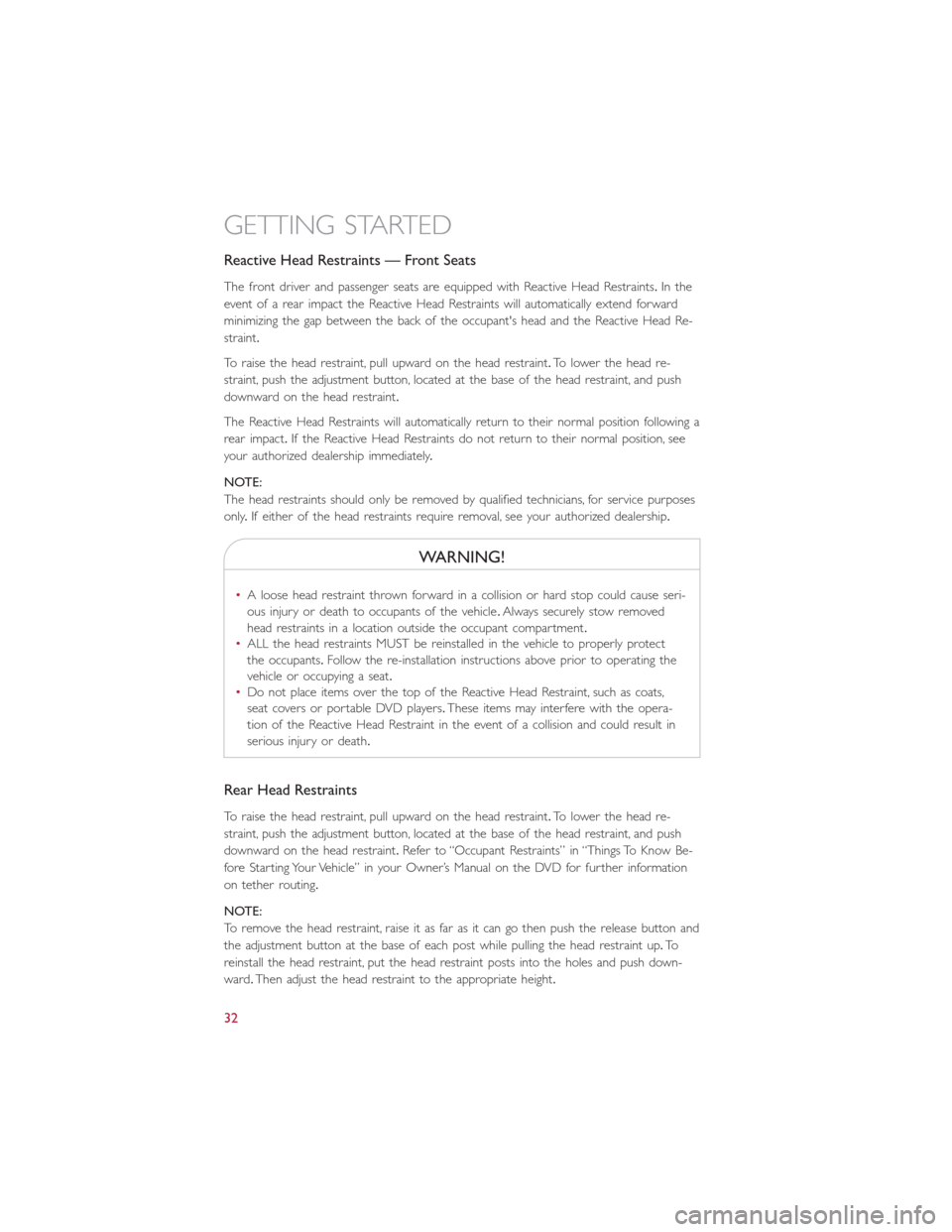
Reactive Head Restraints — Front Seats
The front driver and passenger seats are equipped with Reactive Head Restraints.In the
event of a rear impact the Reactive Head Restraints will automatically extend forward
minimizing the gap between the back of the occupant's head and the Reactive Head Re-
straint.
To raise the head restraint, pull upward on the head restraint.To lower the head re-
straint, push the adjustment button, located at the base of the head restraint, and push
downward on the head restraint.
The Reactive Head Restraints will automatically return to their normal position following a
rear impact.If the Reactive Head Restraints do not return to their normal position, see
your authorized dealership immediately.
NOTE:
The head restraints should only be removed by qualified technicians, for service purposes
only.If either of the head restraints require removal, see your authorized dealership.
WARNING!
•A loose head restraint thrown forward in a collision or hard stop could cause seri-
ous injury or death to occupants of the vehicle.Always securely stow removed
head restraints in a location outside the occupant compartment.
•ALL the head restraints MUST be reinstalled in the vehicle to properly protect
the occupants.Follow the re-installation instructions above prior to operating the
vehicle or occupying a seat.
•Do not place items over the top of the Reactive Head Restraint, such as coats,
seat covers or portable DVD players.These items may interfere with the opera-
tion of the Reactive Head Restraint in the event of a collision and could result in
serious injury or death.
Rear Head Restraints
To raise the head restraint, pull upward on the head restraint.To lower the head re-
straint, push the adjustment button, located at the base of the head restraint, and push
downward on the head restraint.Refer to “Occupant Restraints” in “Things To Know Be-
fore Starting Your Vehicle” in your Owner’s Manual on the DVD for further information
on tether routing.
NOTE:
To remove the head restraint, raise it as far as it can go then push the release button and
the adjustment button at the base of each post while pulling the head restraint up.To
reinstall the head restraint, put the head restraint posts into the holes and push down-
ward.Then adjust the head restraint to the appropriate height.
GETTING STARTED
32
Page 35 of 132
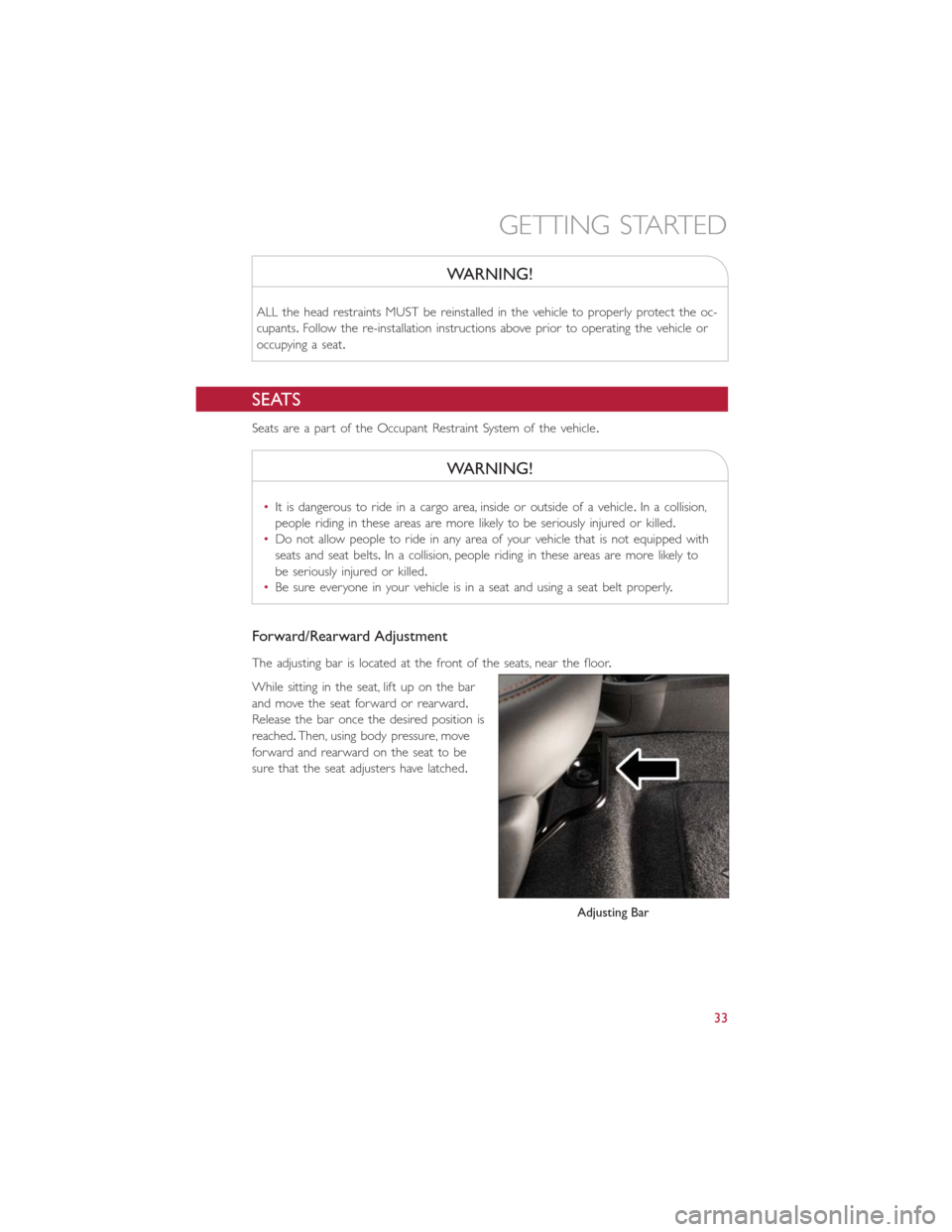
WARNING!
ALL the head restraints MUST be reinstalled in the vehicle to properly protect the oc-
cupants.Follow the re-installation instructions above prior to operating the vehicle or
occupying a seat.
SEATS
Seats are a part of the Occupant Restraint System of the vehicle.
WARNING!
•It is dangerous to ride in a cargo area, inside or outside of a vehicle.In a collision,
people riding in these areas are more likely to be seriously injured or killed.
•Do not allow people to ride in any area of your vehicle that is not equipped with
seats and seat belts.In a collision, people riding in these areas are more likely to
be seriously injured or killed.
•Be sure everyone in your vehicle is in a seat and using a seat belt properly.
Forward/Rearward Adjustment
The adjusting bar is located at the front of the seats, near the floor.
While sitting in the seat, lift up on the bar
and move the seat forward or rearward.
Release the bar once the desired position is
reached.Then, using body pressure, move
forward and rearward on the seat to be
sure that the seat adjusters have latched.
Adjusting Bar
GETTING STARTED
33
Page 36 of 132
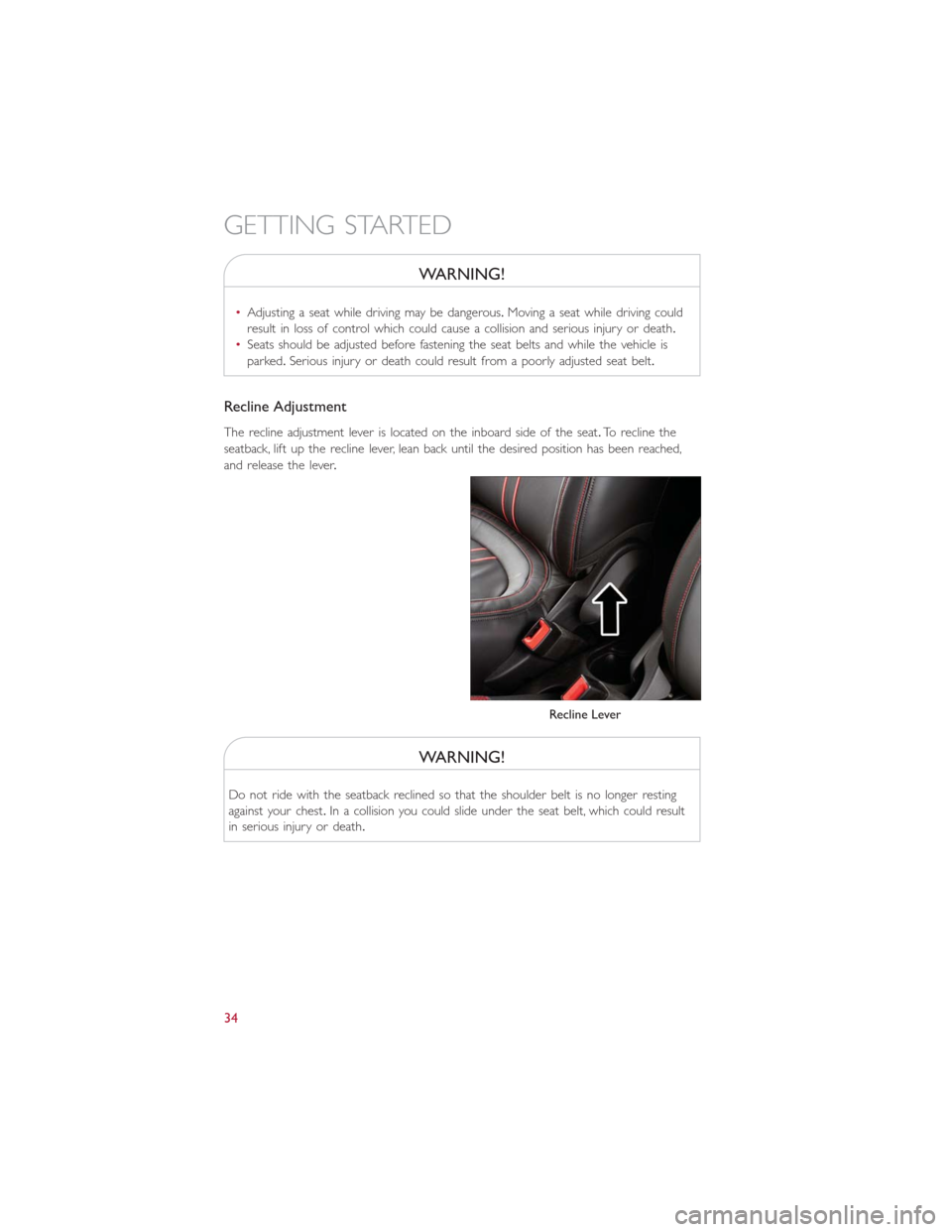
WARNING!
•Adjusting a seat while driving may be dangerous.Moving a seat while driving could
result in loss of control which could cause a collision and serious injury or death.
•Seats should be adjusted before fastening the seat belts and while the vehicle is
parked.Serious injury or death could result from a poorly adjusted seat belt.
Recline Adjustment
The recline adjustment lever is located on the inboard side of the seat.To recline the
seatback, lift up the recline lever, lean back until the desired position has been reached,
and release the lever.
WARNING!
Do not ride with the seatback reclined so that the shoulder belt is no longer resting
against your chest.In a collision you could slide under the seat belt, which could result
in serious injury or death.
Recline Lever
GETTING STARTED
34
Page 37 of 132
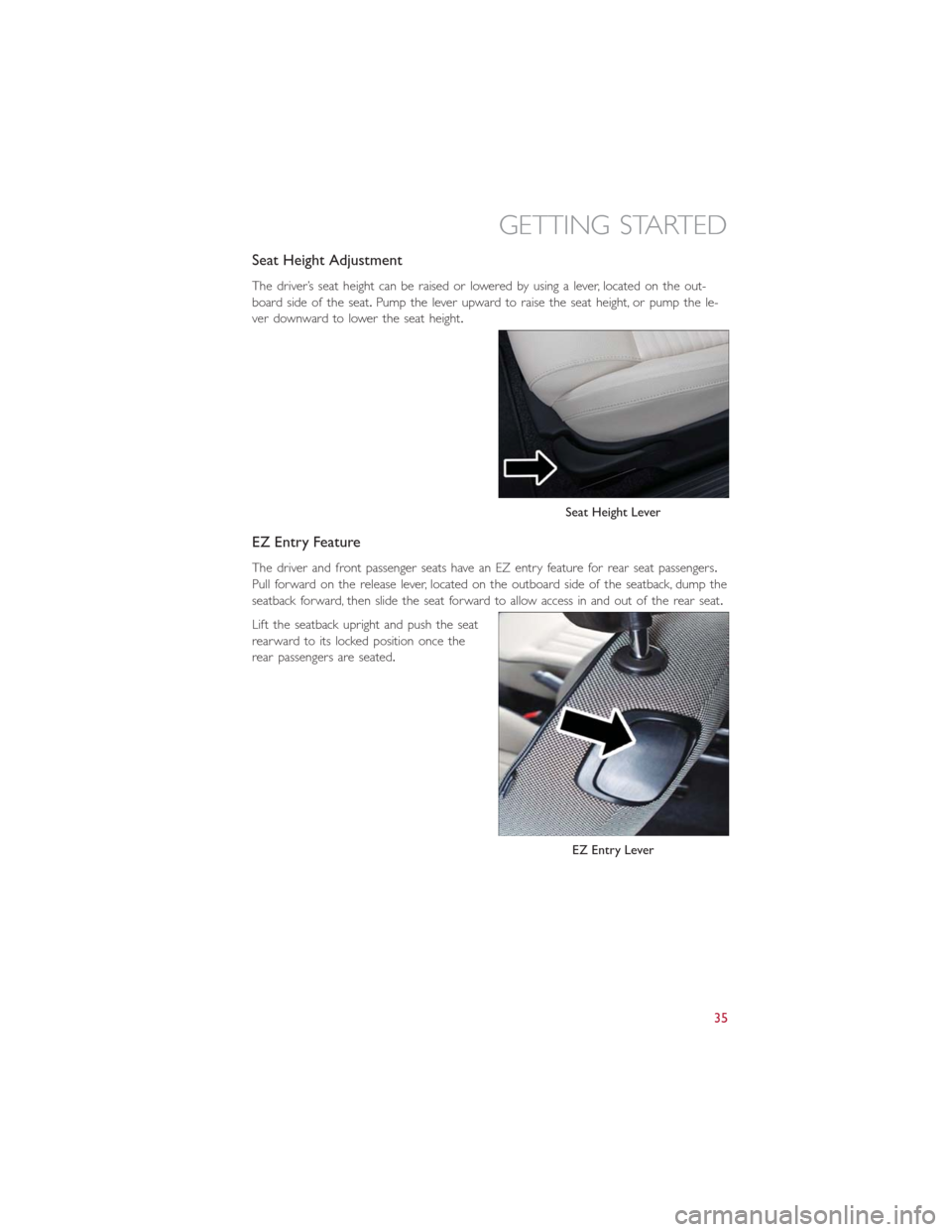
Seat Height Adjustment
The driver’s seat height can be raised or lowered by using a lever, located on the out-
board side of the seat.Pump the lever upward to raise the seat height, or pump the le-
ver downward to lower the seat height.
EZ Entry Feature
The driver and front passenger seats have an EZ entry feature for rear seat passengers.
Pull forward on the release lever, located on the outboard side of the seatback, dump the
seatback forward, then slide the seat forward to allow access in and out of the rear seat.
Lift the seatback upright and push the seat
rearward to its locked position once the
rear passengers are seated.
Seat Height Lever
EZ Entry Lever
GETTING STARTED
35
Page 38 of 132
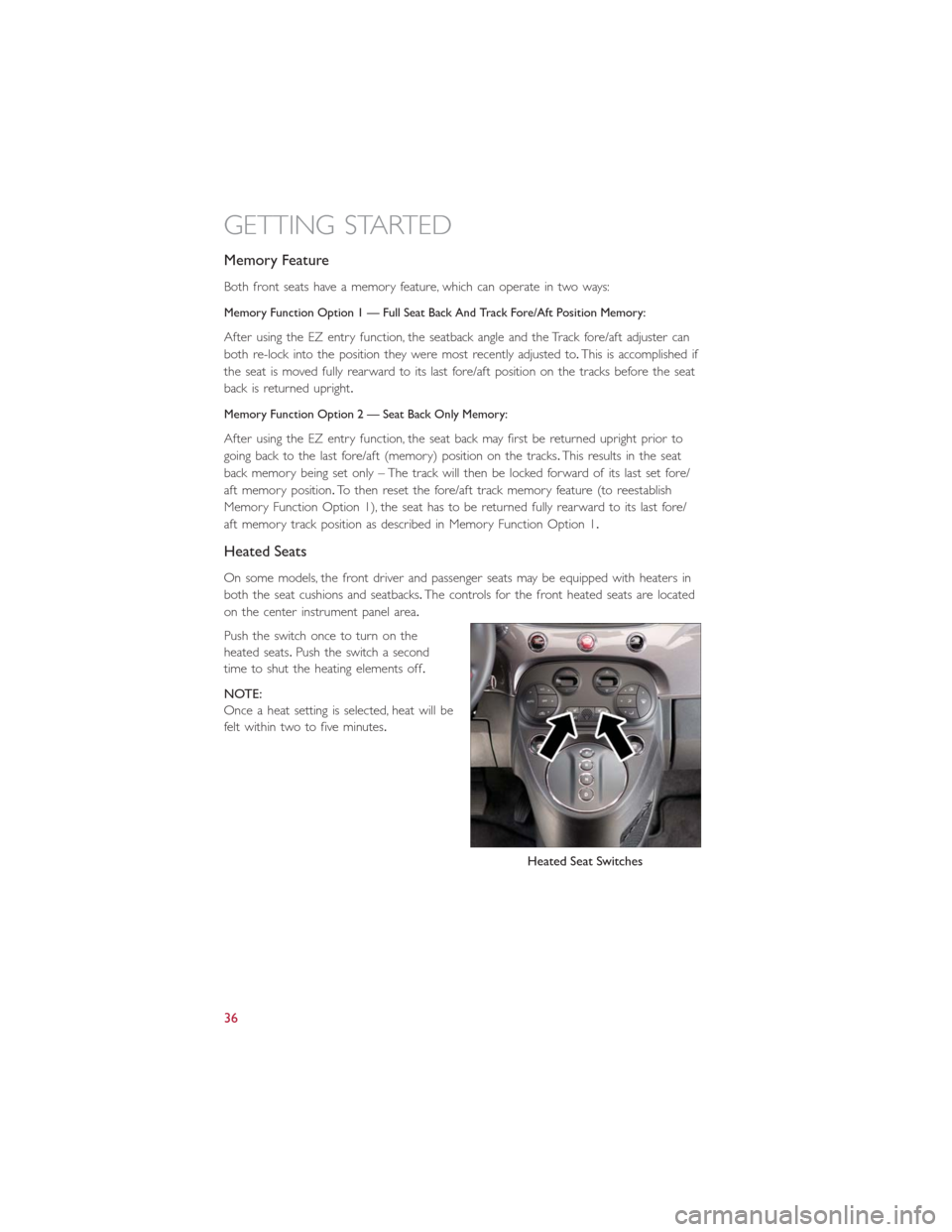
Memory Feature
Both front seats have a memory feature, which can operate in two ways:
Memory Function Option 1 — Full Seat Back And Track Fore/Aft Position Memory:
After using the EZ entry function, the seatback angle and the Track fore/aft adjuster can
both re-lock into the position they were most recently adjusted to.This is accomplished if
the seat is moved fully rearward to its last fore/aft position on the tracks before the seat
back is returned upright.
Memory Function Option 2 — Seat Back Only Memory:
After using the EZ entry function, the seat back may first be returned upright prior to
going back to the last fore/aft (memory) position on the tracks.This results in the seat
back memory being set only – The track will then be locked forward of its last set fore/
aft memory position.To then reset the fore/aft track memory feature (to reestablish
Memory Function Option 1), the seat has to be returned fully rearward to its last fore/
aft memory track position as described in Memory Function Option 1.
Heated Seats
On some models, the front driver and passenger seats may be equipped with heaters in
both the seat cushions and seatbacks.The controls for the front heated seats are located
on the center instrument panel area.
Push the switch once to turn on the
heated seats.Push the switch a second
time to shut the heating elements off.
NOTE:
Once a heat setting is selected, heat will be
felt within two to five minutes.
Heated Seat Switches
GETTING STARTED
36
Page 39 of 132
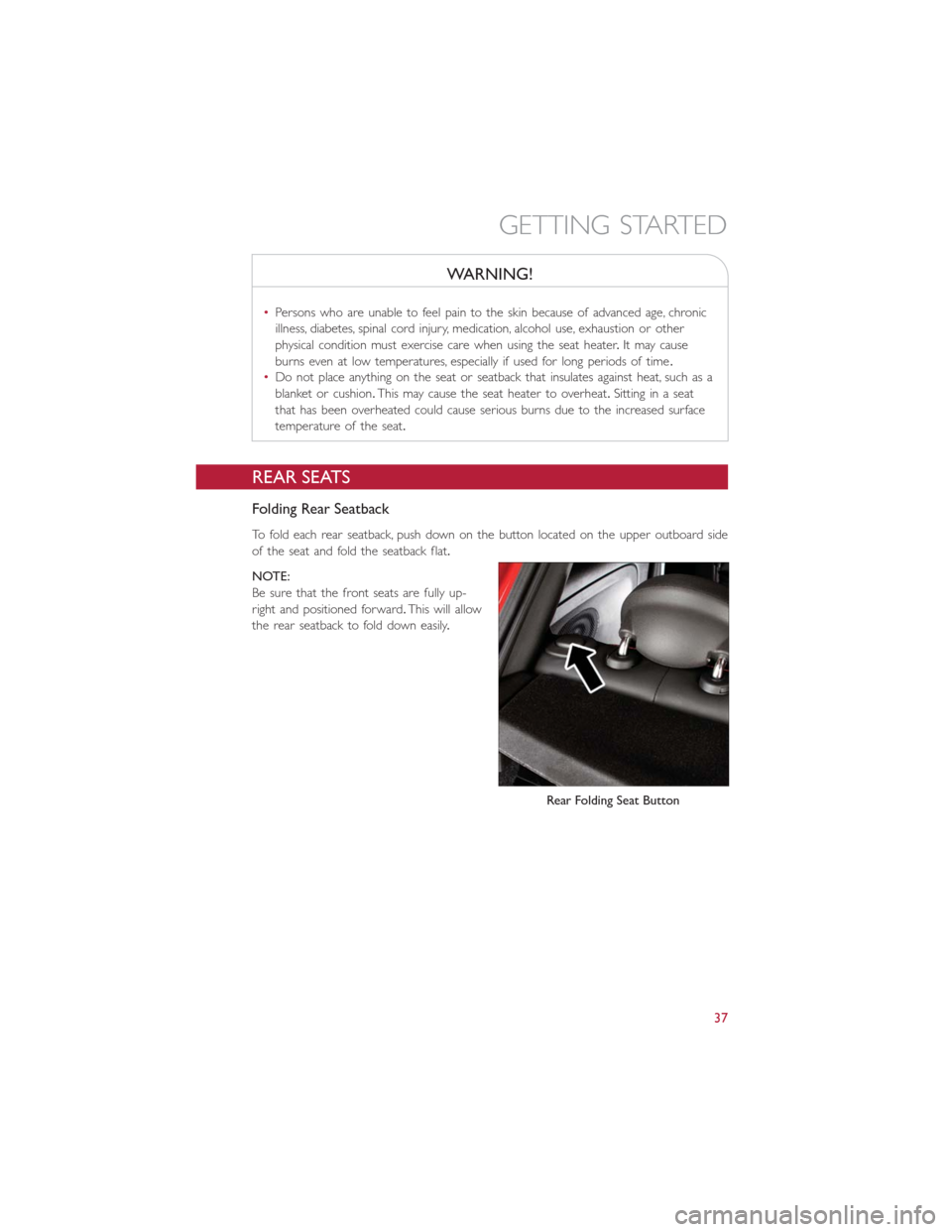
WARNING!
•Persons who are unable to feel pain to the skin because of advanced age, chronic
illness, diabetes, spinal cord injury, medication, alcohol use, exhaustion or other
physical condition must exercise care when using the seat heater.It may cause
burns even at low temperatures, especially if used for long periods of time.
•Do not place anything on the seat or seatback that insulates against heat, such as a
blanket or cushion.This may cause the seat heater to overheat.Sitting in a seat
that has been overheated could cause serious burns due to the increased surface
temperature of the seat.
REAR SEATS
Folding Rear Seatback
To fold each rear seatback, push down on the button located on the upper outboard side
of the seat and fold the seatback flat.
NOTE:
Be sure that the front seats are fully up-
right and positioned forward.This will allow
the rear seatback to fold down easily.
Rear Folding Seat Button
GETTING STARTED
37
Page 40 of 132
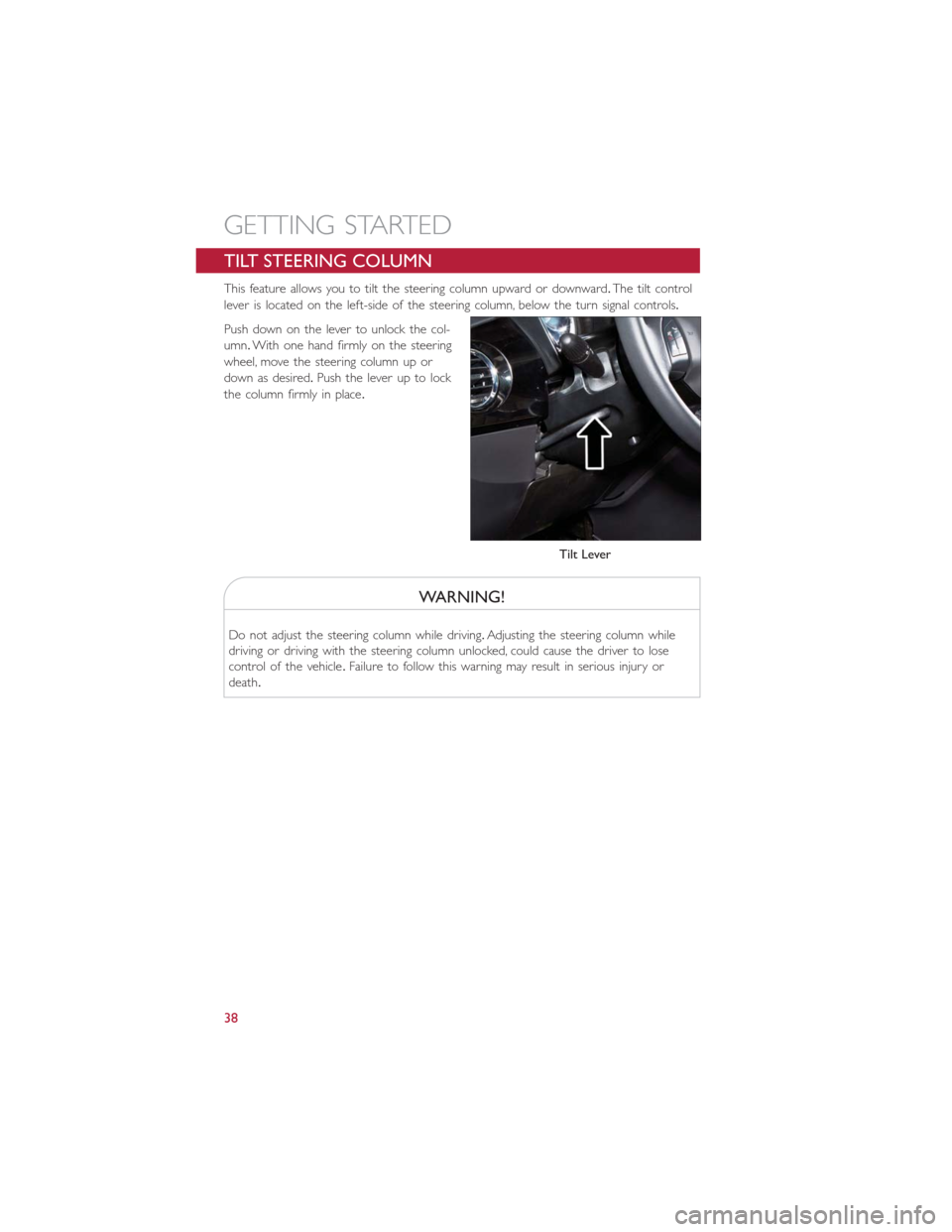
TILT STEERING COLUMN
This feature allows you to tilt the steering column upward or downward.The tilt control
lever is located on the left-side of the steering column, below the turn signal controls.
Push down on the lever to unlock the col-
umn.With one hand firmly on the steering
wheel, move the steering column up or
down as desired.Push the lever up to lock
the column firmly in place.
WARNING!
Do not adjust the steering column while driving.Adjusting the steering column while
driving or driving with the steering column unlocked, could cause the driver to lose
control of the vehicle.Failure to follow this warning may result in serious injury or
death.
Tilt Lever
GETTING STARTED
38